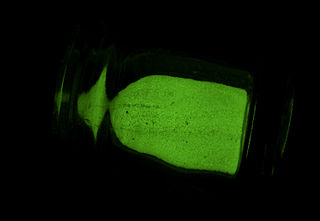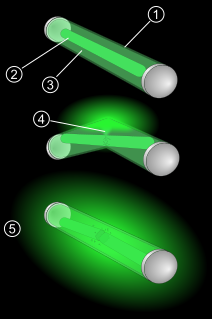
The candela is the base unit of luminous intensity in the International System of Units (SI); that is, luminous power per unit solid angle emitted by a point light source in a particular direction. Luminous intensity is analogous to radiant intensity, but instead of simply adding up the contributions of every wavelength of light in the source's spectrum, the contribution of each wavelength is weighted by the standard luminosity function. A common wax candle emits light with a luminous intensity of roughly one candela. If emission in some directions is blocked by an opaque barrier, the emission would still be approximately one candela in the directions that are not obscured.

Curium is a transuranic radioactive chemical element with the symbol Cm and atomic number 96. This element of the actinide series was named after Marie and Pierre Curie, both known for their research on radioactivity. Curium was first intentionally produced and identified in July 1944 by the group of Glenn T. Seaborg at the University of California, Berkeley. The discovery was kept secret and only released to the public in November 1947. Most curium is produced by bombarding uranium or plutonium with neutrons in nuclear reactors – one tonne of spent nuclear fuel contains about 20 grams of curium.

A light-emitting diode (LED) is a semiconductor light source that emits light when current flows through it. Electrons in the semiconductor recombine with electron holes, releasing energy in the form of photons. The color of the light is determined by the energy required for electrons to cross the band gap of the semiconductor. White light is obtained by using multiple semiconductors or a layer of light-emitting phosphor on the semiconductor device.

The photoelectric effect is the emission of electrons when electromagnetic radiation, such as light, hits a material. Electrons emitted in this manner are called photoelectrons. The phenomenon is studied in condensed matter physics, and solid state and quantum chemistry to draw inferences about the properties of atoms, molecules and solids. The effect has found use in electronic devices specialized for light detection and precisely timed electron emission.

A black body or blackbody is an idealized physical body that absorbs all incident electromagnetic radiation, regardless of frequency or angle of incidence. The name "black body" is given because it absorbs all colors of light. A black body also emits black-body radiation. In contrast, a white body is one with a "rough surface that reflects all incident rays completely and uniformly in all directions."

Luminescence is spontaneous emission of light by a substance not resulting from heat; or "cold light".

A phosphor is a substance that exhibits the phenomenon of luminescence; it emits light when exposed to some type of radiant energy. The term is used both for fluorescent or phosphorescent substances which glow on exposure to ultraviolet or visible light, and cathodoluminescent substances which glow when struck by an electron beam in a cathode ray tube.

An organic light-emitting diode, also known as organic electroluminescentdiode, is a light-emitting diode (LED) in which the emissive electroluminescent layer is a film of organic compound that emits light in response to an electric current. This organic layer is situated between two electrodes; typically, at least one of these electrodes is transparent. OLEDs are used to create digital displays in devices such as television screens, computer monitors, and portable systems such as smartphones and handheld game consoles. A major area of research is the development of white OLED devices for use in solid-state lighting applications.

Bioluminescence is the production and emission of light by a living organism. It is a form of chemiluminescence. Bioluminescence occurs widely in marine vertebrates and invertebrates, as well as in some fungi, microorganisms including some bioluminescent bacteria, and terrestrial arthropods such as fireflies. In some animals, the light is bacteriogenic, produced by symbiotic bacteria such as those from the genus Vibrio; in others, it is autogenic, produced by the animals themselves.

The observable universe is a ball-shaped region of the universe comprising all matter that can be observed from Earth or its space-based telescopes and exploratory probes at the present time, because the electromagnetic radiation from these objects has had time to reach the Solar System and Earth since the beginning of the cosmological expansion. There may be 2 trillion galaxies in the observable universe, although that number has recently been estimated at only several hundred billion based on new data from New Horizons. Assuming the universe is isotropic, the distance to the edge of the observable universe is roughly the same in every direction. That is, the observable universe has a spherical volume centered on the observer. Every location in the universe has its own observable universe, which may or may not overlap with the one centered on Earth.

Chemiluminescence is the emission of light (luminescence) as the result of a chemical reaction. There may also be limited emission of heat. Given reactants A and B, with an excited intermediate ◊,

A glow stick is a self-contained, short-term light-source. It consists of a translucent plastic tube containing isolated substances that, when combined, make light through chemiluminescence. The light cannot be turned off and can be used only once. Glow sticks are often used for recreation, but may also be relied upon for light during military, police, fire, or emergency medical services operations.

The emission spectrum of a chemical element or chemical compound is the spectrum of frequencies of electromagnetic radiation emitted due to an atom or molecule making a transition from a high energy state to a lower energy state. The photon energy of the emitted photon is equal to the energy difference between the two states. There are many possible electron transitions for each atom, and each transition has a specific energy difference. This collection of different transitions, leading to different radiated wavelengths, make up an emission spectrum. Each element's emission spectrum is unique. Therefore, spectroscopy can be used to identify elements in matter of unknown composition. Similarly, the emission spectra of molecules can be used in chemical analysis of substances.

Luciferin is a generic term for the light-emitting compound found in organisms that generate bioluminescence. Luciferins typically undergo an enzyme-catalyzed reaction with molecular oxygen. The resulting transformation, which usually involves splitting off a molecular fragment, produces an excited state intermediate that emits light upon decaying to its ground state. The term may refer to molecules that are substrates for both luciferases and photoproteins.

Black-body radiation is the thermal electromagnetic radiation within or surrounding a body in thermodynamic equilibrium with its environment, emitted by a black body. It has a specific spectrum of wavelengths, inversely related to intensity that depend only on the body's temperature, which is assumed for the sake of calculations and theory to be uniform and constant.

Far infrared (FIR) is a region in the infrared spectrum of electromagnetic radiation. Far infrared is often defined as any radiation with a wavelength of 15 micrometers (μm) to 1 mm, which places far infrared radiation within the CIE IR-B and IR-C bands. The long-wave side of the FIR spectrum overlaps with so named terahertz radiation. Different sources use different boundaries for the far infrared; for example, astronomers sometimes define far infrared as wavelengths between 25 μm and 350 μm.

Pulsar is a brand of watch and currently a division of Seiko Watch Corporation of America (SCA). Pulsar was the world's first electronic digital watch. Today Pulsar watches are mostly analog and use the same movements in Seikos such as the 7T62 quartz chronograph movement.
In quantum gravity, a virtual black hole is a hypothetical micro black hole that exists temporarily as a result of a quantum fluctuation of spacetime. It is an example of quantum foam and is the gravitational analog of the virtual electron–positron pairs found in quantum electrodynamics. Theoretical arguments suggest that virtual black holes should have mass on the order of the Planck mass, lifetime around the Planck time, and occur with a number density of approximately one per Planck volume.

Alpha particles, also called alpha rays or alpha radiation, consist of two protons and two neutrons bound together into a particle identical to a helium-4 nucleus. They are generally produced in the process of alpha decay, but may also be produced in other ways. Alpha particles are named after the first letter in the Greek alphabet, α. The symbol for the alpha particle is α or α2+. Because they are identical to helium nuclei, they are also sometimes written as He2+
or 4
2He2+
indicating a helium ion with a +2 charge. Once the ion gains electrons from its environment, the alpha particle becomes a normal helium atom 4
2He.

Cavernularia is a genus of marine cnidarians in the family Veretillidae.




















